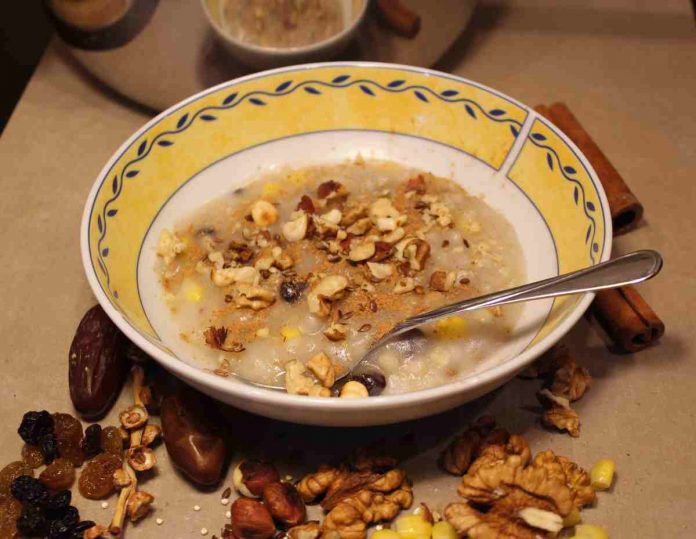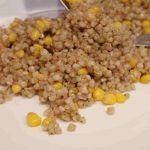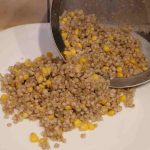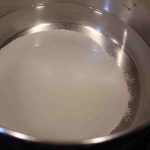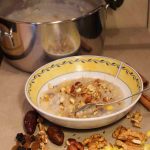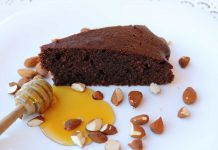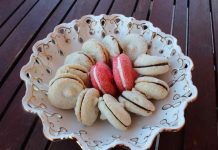Gluten-free multigrain with rice flour
Ingredients
- 35 g hazelnuts (roasted and coarsely chopped)
- 35 g walnuts (coarsely chopped)
- 50g buckwheat
- 10 g white quinoa
- 50 g corn (frozen)
- 20 g brown raisin
- 20 g pale raisin
- one pinch of salt
- 800 g water
- 100 g rice flour
- 100 g sugar (alternatively for sugar-free, we can add 50 g stevia in the end)
- 2 vanillins (powdered) or 1/2 teaspoon vanilla extract
- cinnamon, sesame or linseed
I used to love multigrain as a kid. Every year I knew which neighbour made the best multigrain and I’ve always asked her to keep some extra for me on the same day of Mary’s day. In our neighbourhood, all housewives used to trade among them their dishes that day.
A custom which holds until today.
Since we cook everything lately at home why not multigrain too!!
So, since I am making a custom retrospect over the centuries, I present to you my version of gluten-free multigrains, of course without cereals, but with nutritious seeds and, of course, buckwheat. And for greater convenience with a little frozen corn, but whoever wants to replace it with dried (which first boiled separately).
The proportions I give you are enough for 6 portions.
Do not think they are small. In particular after boiling buckwheat you will see that the original quantity has multiplied.
A hot and sweet dish with all fruits and gluten-free seeds.
The great celebration is November 21st, where the orthodox church celebrates The Presentation of Mary (or Entry of the All-Holy Theotokos).
It is known as “the day of Mary of the Archbishop” or “Mary of Messoroportisas” or “Xesporitissas”, empathetic with agricultural work, or even “Polyspopirtissas”, in order to show our gratitude to the productive land and for the farmers to celebrate the end of sowing and the expectation and hope for a rich productivity.
It is an ancient custom that survived through the centuries.
On this day, it is common in the islands to boil multigrains, the so-called maergia, which as food has its roots in Ancient Greece.
It is a kind of soup, with different pulses, that was made in an Athens feast, the ancient Pianepsia or Pyanopsia or Panopsya.
In fact, they made a bloodless sacrifice with fruits and berries, the first fruits of the annual harvest, to please God Apollo and the Goddess Athena who protected the fertility of the land in last year and to ask the gods to help them in the harvest in the next year too.
The great men gathered outside the temple of Apollo and crowned children (with branches of olive and laurel) offered them from this food-candy. Then they were walking from house to house, singing and the hosts took a branch of their hair hanging on the door and giving
them treats.
Method
Rinse and strain the quinoa and buckwheat.
In a saucepan with water, add the salt and boil the quinoa and buckwheat for 10 minutes.
Add the frozen corn and boil for another 4-5 minutes.
Strain and wash out.
In a separate saucepan, add the 700g water in medium heat.
Add the sugar and let it boil.
(remember: if we don’t add sugar, stevia will be added in the end of the boil)
Pour in the saucepan the strained seeds (buckwheat, quinoa, corn), raisins, dates and stir.
In the rest 100g of water, pour the rice flour and stir. It doesn’t thicken immediately and it won’t.
Add it in the saucepan and stir steadily until it starts to thicken.
Remove from heat when the mixture starts to seethe.
Add the vanilla (which we can easily skip), a pinch of powdered cinnamon and serve.
Decorate with coarsely chopped hazelnuts, walnuts and sesame or linseed.
Enjoy it warm!!
Nutritional information per 100 g
Energy / calories: 140.69 kcal
Proteins: 2.79 g
Carbohydrates: 26.5 g
Fat: 4.39 g





